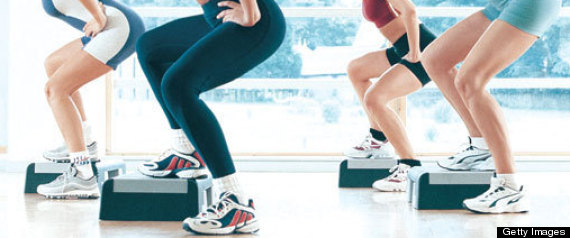By Kristen Domonell for Life by DailyBurn
Ready to hit the slopes this winter? If you spend most of your week cooped up at a desk, weekend ski and snowboard trips could leave you with strained muscles and a sore back. But with the right preparation, including strengthening your hamstrings, quadriceps, back and core, you won’t have to risk injury or suffer from the usual aches and pains, says Mike Morin, alpine program director at Stratton Mountain School, who coached the U.S. Ski Team for 10 years through the Lillihammer, Salt Lake City and Torino Winter Olympics. These five exercises, recommended by Morin, will get you into the right shape to be a true winter weekend warrior.
More from Life by DailyBurn: The Best Ski and Snowboard Vacations in the U.S.
1. Toy Soldiers
Having flexible hamstrings is crucial for skiing and snowboarding, says Morin. While something as simple as a seated forward bend can stretch your hamstrings, active and dynamic stretches like the toy soldier are most effective, he says.
How to: To start, stand up straight with your left arm out to your side at shoulder height. Without bending your knee, kick your right leg while extending your left arm out in front of you to touch your toe. Repeat with the left leg and right arm. Complete three sets of 10 to 12 reps on each side, alternating legs, moving forward with a step in between each kick.
2. Step-Ups

Skiing and snowboarding are both “leg sports,” so strengthening the quads is hugely important, Morin says. “When you start skiing and snowboarding, all of a sudden you’re using these big ranges of motion you wouldn’t normally use.” Step-ups not only strengthen your quads and glutes, but also improve range of motion. Plus, you’ll be able to brush up on your balance and coordination, which you’ll definitely need on the slopes.
How to: Stand facing a box, step or chair and place your right foot on the flat surface. Step your left leg up to meet your right, by pushing into your right foot and using the muscles in the right leg to propel you (rather pushing off your left foot). Step down with your left leg, then your right. Complete three sets of 10 to 12 reps and then switch legs.
More from Life by DailyBurn: 7 No-Crunch Exercises for Six-Pack Abs
3. Physioball Hamstring Curl
“Whenever you strengthen one side of the body, you want to balance and strengthen the other,” says Morin. That means it’s a good idea to follow up a quad exercise with one to strengthen the hamstrings.
How to: Begin laying on your back, palms down on the floor, with your legs extended and your feet resting on top of a large exercise ball. Using your leg and core strength, begin to draw the ball in toward your body until your knees are bent and you’re in a shoulder bridge position. Hold this position for a couple seconds before returning to the starting position. Need more of a challenge? Try single leg curls (pictured above) to really test your hamstring and glute strength. Repeat for three sets of 10 to 12 reps.
4. Planks And Side Planks

Also hugely important to downhill sports: the core. There’s no need to get fancy, Morin says. Basic planks and side planks will do the trick. Trust us, if you don’t do core work, you’ll regret it after a few runs.
How to: Balancing on your forearms in a push-up position, use the strength of your abdominals and glutes to keep your hips raised to shoulder height, taking extra care not to sag in the midsection. For the side plank, shift from a plank position onto one hand, with the other either extended into the air or on your hip and your feet stacked. Complete three sets (one regular plank and one on each side) of 30- to 60-second holds.
More from Life by DailyBurn: 10 Irresistible Protein Cookie Recipes
5. Supermans
To compensate for sitting all day long during the week, it’s important to exercise the lower back before hitting the slopes, Morin says. The stronger your back, the less likely you’ll experience lower back pain as a result of a day on the mountain.
How to: Start by lying on your stomach with your arms extended out in front of you. Slowly lift your arms and upper body, keeping your neck in a neutral position. At the same time, lift your legs off the ground, keeping your ankles as close together as you can. Hold for a few seconds before returning your arms and legs back to the floor. Complete three sets of 30 to 60 second holds.
When you’re just starting out, complete the recommended sets and reps listed above. As you progress, try moving on to a timed workout, doing 30 seconds of each exercises back-to-back, Morin suggests.
“If you build yourself up to doing 30-second intervals of these exercises, and then start to add minutes onto the routine, you’ll really build yourself up to a place where you can develop a strong base for skiing and snowboarding,” he says.
And don’t forget to warm up before getting on the lift. A few reps of dynamic moves like toy soldiers and step-ups will get you warm and limber. After your ski or snowboard session, some long, static stretches will get you ready for day two, as will some well-deserved hot tub time.
